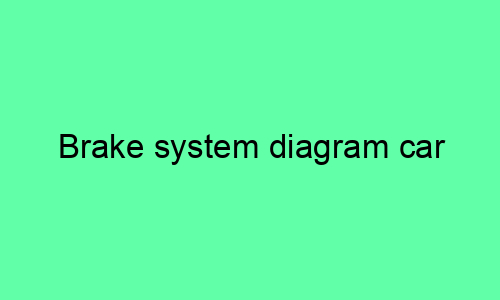Brake System Diagram Car
Introduction
The brake system is one of the most important safety features on a car. It is responsible for slowing down and stopping the vehicle when the driver applies pressure to the brake pedal. The brake system is made up of several components, including the brake master cylinder, brake fluid, brake lines, brake calipers, and brake pads.
Brake Master Cylinder
The brake master cylinder is the heart of the brake system. It is responsible for converting the force applied to the brake pedal into hydraulic pressure. The brake master cylinder is located under the hood of the car, and it is connected to the brake pedal by a pushrod. When the driver presses the brake pedal, the pushrod pushes on the brake master cylinder piston, which in turn forces brake fluid out of the master cylinder and into the brake lines.
Brake Fluid
Brake fluid is a hydraulic fluid that is used to transmit the pressure from the brake master cylinder to the brake calipers. Brake fluid is made up of a base oil, additives, and a dye. The base oil is responsible for providing the fluid with its lubricating properties, while the additives help to protect the brake system components from corrosion and wear. The dye is used to help identify leaks in the brake system.
Brake Lines
Brake lines are the tubes that carry the brake fluid from the brake master cylinder to the brake calipers. Brake lines are made of steel or copper, and they are coated with a protective coating to help prevent corrosion. The brake lines are routed throughout the car, and they are connected to the brake calipers by banjo bolts.
Brake Calipers
Brake calipers are the components that apply pressure to the brake pads and rotors. Brake calipers are mounted to the wheel hubs, and they are connected to the brake lines by banjo bolts. When the driver presses the brake pedal, the brake fluid flows into the brake calipers and causes the pistons in the calipers to move outward. The pistons push on the brake pads, which in turn apply pressure to the brake rotors.
Brake Pads
Brake pads are the components that make contact with the brake rotors and create friction to slow down or stop the vehicle. Brake pads are made of a composite material that is designed to resist wear and heat. The brake pads are mounted to the brake calipers, and they are replaced when they become worn.
Brake Rotors
Brake rotors are the discs that the brake pads press against to slow down or stop the vehicle. Brake rotors are made of cast iron or steel, and they are mounted to the wheel hubs. The brake rotors are designed to dissipate heat and wear evenly.
How the Brake System Works
When the driver presses the brake pedal, the brake master cylinder converts the force applied to the pedal into hydraulic pressure. The brake fluid flows through the brake lines and into the brake calipers. The brake calipers apply pressure to the brake pads, which in turn apply pressure to the brake rotors. The friction between the brake pads and rotors slows down or stops the vehicle.
Brake System Maintenance
The brake system is a critical safety feature, and it is important to keep it in good working order. The brake system should be inspected regularly by a qualified mechanic, and the brake fluid should be flushed and replaced every two years. The brake pads should be replaced when they become worn, and the brake rotors should be inspected and replaced if necessary.
Conclusion
The brake system is one of the most important safety features on a car. It is responsible for slowing down and stopping the vehicle when the driver applies pressure to the brake pedal. The brake system is made up of several components, including the brake master cylinder, brake fluid, brake lines, brake calipers, and brake pads. It is important to keep the brake system in good working order by having it inspected regularly and by replacing worn components.






